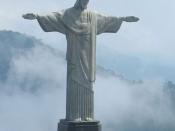A very appropriate film to use when conducting an analysis of the politics of representation of crime and criminalization is 'The City of God'. This is a very powerful film that deals with troubled youth in the heart of Brazil, Rio de Janeiro. This film is based on a true story but it is the story that is being 're-presented' to us that we should be most interested in. It is also very important that while doing an analysis like this, a great deal of attention is paid to the intersecting variables, which are evident throughout the film. By doing this, an intersectional analysis will help us to account for the way characters in this film, most notably the poor young Black male, are constructed to produce a particular kind of representation. Besides the politics of representation, however, another important theme, which arises constantly from this film, is the idea of strain theory, and a few examples of this will be demonstrated throughout.
What the politics of representation means to me, is the idea that what is represented to us can be viewed through many different lenses, but only after it is "re-presented" through one of many lenses. It is all about the way in which meaning is given to the things that are being represented. In the politics of representation, you are more focused on figuring out what is being represented as opposed to some true meaning. Stuart Hall says that this is because 're-presentation' does not capture what is going on. "Events do not really exist until they are represented" (Hall.1997. Representation and the Media). They have no fixed, real meaning and this is because 'true meaning' depends on what people make of it and so depends again, on how it is represented.
"Whether reading or watching legal fiction, it is important to differentiate between the story and the moral of the story, what the story says and what it means. The story is the actual description of events, what happened to whom. However, the story is really just the means to the end, the moral of the story" (Lenz. 2003.17). What Timothy Lenz tries to tell us is that written presentation can be useful because of the ability to use language to explain complex ideas or actions, whereas visual storytelling must overcome this barrier and to do this there have been developed forms of presentation that help viewers read the story. An example of this is the typical idea of a wrongly accused cop who is suspended from work. This is a type of convention, which helps viewers understand scenes and get a better sense of emotion. In 'The City of God' it seems that most characters have what Lenz refer to as a common idea in newer works, and that is both positive and negative characteristics. A scene in this film where this type of convention, which helps viewers understand scenes and get a better sense of emotion is when one of the 'hoods' who had just hijacked a car with his girlfriend, was then being chased on foot by police and as he was getting shot at, there are constant visuals of his girlfriend, who is crying for him as she is watching him be shot to death. This scene is important because it is one that makes clear the importance of differentiating between determining the facts of a crime story, and that is what it says, and determining the moral of the story, which is what it means.
The subject of the text 'The City of God' is the problem of youth street crime in Rio de Janeiro. The most evident theme in the movie is that street crime is a predictable consequence of life in a society that tolerates appalling levels of poverty. The idea of subject related to theme is a great deal like Stuart Hall's idea of meaning being given to the things being represented. This film does also a very good job of keeping the stereotype that the darker the persons skin; the more violent and criminal they are going to be.
"The City of God" is a very violent and criminal film, which focuses on the idea that in Rio de Janeiro, you have a choice to make in your life. You can go to school and work very hard for next to nothing, or you can become a hoodlum. The 'hoods' as they are referred to in the film, are part of violent, youth, street gangs, which commit crime after crime and rarely ever feel the repercussions of their actions. Besides the idea that street crime is a predictable consequence of life in a society that tolerates appalling levels of poverty, another theme that relates to the problem of youth street crime is how much these acts are glorified. It seems that almost every kid in the film wants to grow up and take over a part of the city to sell drugs or what they refer to as 'running the business'. Even most of the kids who seem very level headed and destined to break the vicious cycle of violence, somehow get sucked into it, whether it is for glory, respect, following family members, or most notably, revenge. There is definitely no shortage of the stereotypical, violent black male in this film.
Many of these ideas, which were just mentioned, have a great deal to do with the strain theory. This theory is somewhat similar to the idea of anomie but differs because the real problem is not created by a sudden social change, as Durkheim proposed, but rather by a social structure that holds out the same goals to all its members without giving them equal means to achieve them. It is this lack of integration between what the culture calls for and what the structure permits that causes deviant behaviour. Deviance then is a symptom of the social structure. The youth in Rio de Janeiro have but a simple choice to make in their life and this is to go to school and work as hard as they can for next to nothing or become violent criminals. The strain theory in this case, is a powerful tool, which allows us to understand the conditions that these youth are among and the fight that they must face, in order to live a life outside of poverty. It seems as though the only way to discontinue this trend of having youth have such a simple decision is to implement a social structure, and cultural norms, which can help the youth. "The need for cultural participation is strongly expressed by numerous forms of violence" (Peralva. 1994.23).
If a type of solution such as this can be made, it would also help to alleviate the very visible stereotype which has already been mentioned a couple of times and that is the violent image of the poor young Black male. The variables race, gender, class and age are all important variables, which can be taken into account when thinking critically about the film 'The City of God'. Age is important to consider because it seems that youth, or even little children are being represented as the ones who do all the crime that is committed. Whether it is youth on youth crime, or youth on elderly people, being a young successful criminal, is the most glorified and respected thing you can do in the eyes of your peers in 'The City of God'.
A slightly more important variable is the division of gender. Of all the crime that is committed in this film, not a single act is by a female. The only exceptions to this are the very rare 'pot' smoking scenes. Other than that, females are made out to be loving, care givers, who just want what is best for their family or boyfriend. Males, however, are represented mainly as hoodlums, and nothing else. It seems that it is every boy's dream, to become a leader of some part of the 'hoods'. Males are constructed to produce this image of power obsessed, violence driven delinquents.
Perhaps an even more important variable is race. Although it seems that most every character in the movie is Brazilian, it is still those of the darkest skin, which are made out to be the most dangerous villains of all. It is class, however, that is the most independent variable in this film. Everyone in Rio de Janeiro is at most only fairly poor. They are all trying to find a way out of there. And in order to find their way out, they turn to violence and crime to help pay their way out. Holding people at gunpoint seems to be the crime of choice.
These four variables are all intersecting and have a strong tie to the act of crime in Rio de Janeiro in 'The City of God'. For example, the most prominent criminals in this film are represented through the construction of producing the typical or stereotypical, poor young Black male. All four of these variables are made clear to be important, in the construction of this film. There is only one character in 'The City of God', which fits the profile of those four variables, and is not a violent criminal. His name is Rocket. If any one of those four variables is taken away, however, then the person may not be a violent criminal. But if all four variables apply, then this movie has made it clear, that that person must be a violent criminal.
It is quite easy, however, for films to represent criminals to us in such a way when you consider the fact that historically, Black young men have been represented in most societies as potential criminals who should be feared. "This stigmatizing of Black people as a 'problem group' that through criminal activities is likely to threaten the social order, safety, and security of citizens not only racializes but also criminalizes them, consequently turning them into a group, that is 'always under suspicion'" (James. 2002.294). The terms 'driving while black' or even 'walking while black' are popular because race is a major determinant of an individual's chances of being stopped and questioned by police, whether that individual is driving or walking.
Over the past several years there have been many attempts specifically within the film industry, to change this notion surrounding Blacks. Movies such as Coffy, Foxy Brown, Shaft and Super Fly are all good examples, which try to characterize Blacks of both male and female with very positive depictions. In many of these films, however, success is achieved through extreme forms of violence. There are very few works that illustrate the strain theory and show success being gained by a character who, is faced with the four variables mentioned earlier. The character in 'The City of God' who is named Rocket is one. Another work, which helps to show success being gained by those faced with the strain theory, is 'Beat Street', which is a subcultural urban hiphop musical, which concerns a group of young ghetto blacks who have no future outside of music or dance. This idea is much like the situation that Rocket is faced with, as he has no future outside of his potential to be a great photographer. "They are depicted as people with great artistic ability who are prevented by circumstances, especially lack of access to higher education, from realizing their potential" (Ryan, Kellner. 1988.128). The film portrays cross-race friendships and suggests that blacks from different classes should help each other which goes back to the earlier mentioned idea that in order for youth to break the cycle of violence, when faced with the strain theory, we need to implement a social structure, and cultural norms, through cultural participation, which can help the youth overcome some of the barriers they are faced with.
To say, however, that youth need such a device to successfully escape their situation, is again representing them in a certain way, which may not be the 'true meaning' they would have chose for themselves, but the way they are being represented nonetheless. "Stereotyping is a problem that refuses to go away. It recurs, across various contexts and discourses, as a divisive and troubling issue, and remains a central source of contention in the politics of representation. Yet what it involves as a symbolic process, and how it may be considered as a critical concept, are themselves part of the problem" (Pickering, 2001.x). The idea behind this is that stereotyping has to tell a bigger story. Representations of people in films have the power to select, arrange, and prioritize certain assumptions and ideas about different kinds of people, and both demonize and idealize certain situations as seen in 'The City of God'. What is actually being represented in the film at times must be seen through different lenses. The first lens is the one, which demonizes the youth of Rio de Janeiro for the violent acts and criminal behaviour they take part in, and the second lens idealizes those exact same actions.
When it comes to films, the politics of representation cover both the power to speak of and for others. This makes very clear the idea that what is represented to us can be viewed through many different lenses, but only after it is "re-presented" through one of many lenses. Presenting through one of many lenses, however, may help viewers read the story, but much like Timothy Lenz and his ideas about developed forms of presentation, this is one way to continue the flow of stereotypical sounds and images that are being conveyed to the viewers who may take them as 'true meaning'. 'The City of God' has chosen to represent the youth of Rio de Janeiro not so much as a group of people who need help with regards to strain theory, but the meaning which is given to these youth who are being represented is actually much more stereotypical than that. This 're-presentation' of everyday life in Rio de Janeiro does not quite capture what is going on, but what is represented to us is that many of these youth are violent and it is because of their race, gender, class and age. As mentioned earlier, all four of these variables intersect and have a strong tie to the act of crime in this film. 'The City of God' has represented the typical criminal as a poor young Black male. If any one of these four variables is taken away, however, then the person may not be a violent criminal. But what is being re-presented to us is the idea that if all four variables apply, it is quite clear that a violent criminal is the best way to describe this person.


